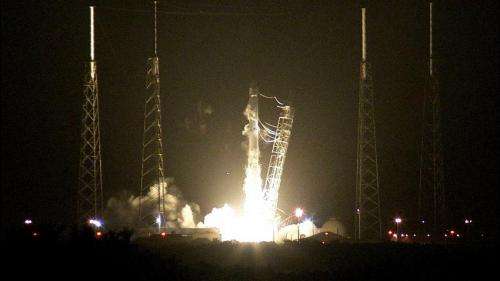NASA launches RapidScat wind watcher to Space Station

A new NASA mission that will boost global monitoring of ocean winds for improved weather forecasting and climate studies is among about 5,000 pounds (2,270 kilograms) of NASA science investigations and cargo now on their way to the International Space Station aboard SpaceX's Dragon spacecraft. The cargo ship launched on the company's Falcon 9 rocket from Space Launch Complex-40 at Cape Canaveral Air Force Station in Florida at 10:52 p.m. PDT Saturday, Sept. 20 (1:52 a.m. EDT Sunday, Sept. 21).
The SpaceX mission is the company's fourth cargo delivery flight to the space station through a $1.6 billion NASA Commercial Resupply Services contract. Dragon's cargo will support experiments to be conducted by the crews of space station Expeditions 41 and 42.
The International Space Station-Rapid Scatterometer, or ISS-RapidScat, mission will monitor ocean winds from the vantage point of the space station. This space-based scatterometer, developed by NASA's Jet Propulsion Laboratory, Pasadena, California, is a remote sensing instrument that uses radar pulses reflected from the ocean's surface from different angles to calculate surface wind speed and direction. This information will be useful for weather and marine forecasting and hurricane monitoring.
ISS-RapidScat's berth on the space station will put it in an orbit that is unique from any other wind measuring instrument currently in orbit. This vantage point will give scientists the first near-global direct observations of how ocean winds vary over the course of the day due to solar heating. The new mission will also provide cross-calibration of the international constellation of ocean wind satellites, extending the continuity and usefulness of the scatterometer data record.
Approximately nine days after berthing with the station, the RapidScat instrument and its nadir adapter, which orients the instrument to point down at Earth, will be robotically installed on the External Payload Facility SDX site of the Columbus module over a three-day period by the station's robotic arm, which is controlled by ground controllers at NASA's Johnson Space Center. ISS-RapidScat is an autonomous payload, requiring no interaction from station astronauts.
Using a different end effector—a mechanical hand—the station's robotic arm will first extract RapidScat's nadir adapter from the trunk of the Dragon and install it on an external site on the Columbus module. The arm will then pluck the RapidScat instrument assembly from the Dragon's trunk and attach it to the nadir adapter, completing the installation. Each of the two operations will take about six hours.
Once installed, RapidScat will be activated over a period of three days. Checkout of RapidScat will be completed approximately two weeks after installation. About two weeks of preliminary calibration and validation will then follow. RapidScat will then be ready to begin its two-year science mission.
Dragon also will deliver the first-ever 3-D printer in space. The technology enables parts to be manufactured quickly and cheaply in space, instead of waiting for the next cargo resupply vehicle delivery. The research team also will gain valuable insight into improving 3-D printing technology on Earth by demonstrating it in microgravity.
New biomedical hardware launched aboard the spacecraft will help facilitate prolonged biological studies in microgravity. The Rodent Research Hardware and Operations Validation (Rodent Research-1) investigation provides a platform for long-duration rodent experiments in space. These investigations examine how microgravity affects animals, providing information relevant to human spaceflight, discoveries in basic biology and knowledge that may have direct impact toward human health on Earth.
The Dragon spacecraft will also transport other biological research, including a new plant study. The Biological Research in Canisters (BRIC) hardware has supported a variety of plant growth experiments aboard the space station. The BRIC-19 investigation will focus on the growth and development in microgravity of Arabidopsis thaliana seedlings, a small flowering plant related to cabbage. Because plant development on Earth is impacted by mechanical forces such as wind or a plant's own weight, researchers hope to improve understanding of how the growth responses of plants are altered by the absence of these forces when grown in microgravity.
Dragon is scheduled to be grappled at 4:04 a.m. PDT (7:04 a.m. EDT) on Tuesday, Sept. 23, by Expedition 41 Flight Engineer Alexander Gerst of the European Space Agency, using the space station's robotic arm to take hold of the spacecraft. NASA's Reid Wiseman will support Gerst in a backup position. Dragon is scheduled to depart the space station in mid-October for a splashdown in the Pacific Ocean, west of Baja California, bringing from the space station almost 3,200 pounds (1,450 kilograms) of science, hardware and crew supplies.
The space station is a convergence of science, technology and human innovation that demonstrates new technologies and makes research breakthroughs not possible on Earth. NASA recently awarded contracts to SpaceX and The Boeing Company to transport U.S. crews to and from the space station with the goal of certifying those transportation systems in 2017.
Provided by NASA




















